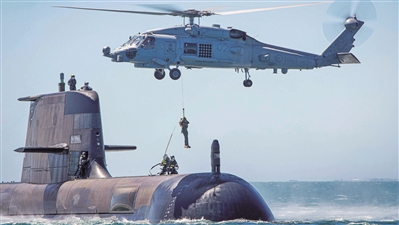By Liu Liang

Lately, the news about the US and the UK helping Australia build nuclear submarines has not only seriously disgruntled France whose submarine contract with Australia was called off as a result, but also triggered heated discussions and arguments in the international community. At present, the trilateral cooperation on the research and manufacturing of nuclear submarines is in a very early stage and the technical and other details are not finalized yet. Although nuclear submarine has more advantages than conventional ones, it is just a good choice on the surface for Australia because once it enters the substantive stage, more difficulties will pop up and likely put a heavy burden on the country.
On the one hand, the project itself is problem-riddled. Australia originally planned to work with France to build 12 Barracuda-class conventional submarines to replace its six aged Collins-class submarines, and the first one is projected by foreign media to start serving in the early 2030s. Now that Canberra canceled its contract with Paris and turned to Washington and London for nuclear submarine cooperation, it won’t be able to get its first new submarine until 2040, at which time its youngest Collins-class submarine would have served nearly 40 years. The Australian Navy is seeking to rent submarines to fill in the gap before its new nuclear submarines can be commissioned.
Australia is inexperienced in submarine development and hasn’t fully grasped the technologies of conventional ones yet, so there is a big question mark over whether it can digest the complicated nuclear submarine technology even with America and Britain’s help. The Collins-class submarine is developed with Sweden’s Västergötland-class littoral submarine as the prototype. Australian Navy reckoned that since the prototype is an excellent littoral submarine, the Collins-class, a simple three-fold magnification of it, must be an excellent ocean-going submarine. This unscientific and even childish thought has led to constant problems with the Collins-class and a high maintenance cost.
On the other hand, nuclear submarines will be a heavy burden on Australia. Although Canberra has worked out an ambitious plan, it may not be able to bear the huge cost of design, manufacture and use. The nuclear submarine is a money guzzler. Even the less expensive one – the Virginia-class attack submarine of the US Navy – once cost USD 2.7 billion each and later rose to USD 3 billion, while the Columbia-class ballistic missile nuclear-powered submarine that’s under construction now costs as much as USD 7 billion. Even if Australia’s nuclear submarine isn’t as large as its American and British counterparts, the redesign and re-manufacturing alone mean an astronomical figure.
At the same time, nuclear reactor, a vital part of the nuclear submarine, has to be operated and maintained by a large number of professionals, which Australia doesn’t have because it has no nuclear power station. Of course, it can still rely on the US and the UK to cultivate nuclear professionals for it and then establish its own talent cultivation system and talent pool step by step, but that will be a long and expensive process.
Moreover, Australia’s so-called nuclear submarine will probably use a nuclear reactor that, like American and British ones, uses highly enriched uranium (HEU) as fuel and relies on fuel supply from the two countries. The US Navy’s HEU for nuclear-powered submarines and aircraft carriers is expected to deplete in 2060, so there is no telling whether Australia’s HEU demand can be met. It’s worth noting that HEU can be used to make nuclear weapons, which is an important reason why the trilateral cooperation in nuclear submarine development is so widely criticized.
Analysts said that as the Australian economy depends on resource export, the country has neither the industrial capability to design and manufacture a nuclear submarine, nor the professionals to operate it, nor the financial strength to afford such a money-guzzling undertaking. Developing nuclear submarines will squeeze the capital needed to upgrade other weapons and equipment, and put a huge economic burden on the country, causing a series of economic and political chain effects.













